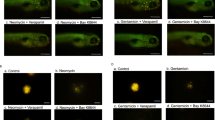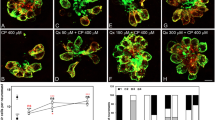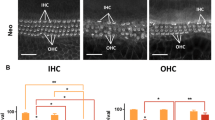Abstract
A major side effect of aminoglycoside antibiotics is mammalian hair cell death. It is thus intriguing that embryonic chick hair cells treated with aminoglycosides at embryonic day (E) 12 are insensitive to ototoxicity. To exclude some unknown factors in vivo that might be involved in preventing aminoglycoside damage to embryonic hair cells, we first cultured chick embryonic basilar papilla (BP) with an aminoglycoside antibiotic in vitro. The results indicated that the hair cells were almost intact at E12 and E14 and were only moderately damaged in most parts of the BP at E16 and E18. Generally, hair cells residing in the approximate and abneural regions were more susceptible to streptomycin damage. After incubation with gentamicin-conjugated Texas Red (GTTR), which is typically used to trace the entry route of aminoglycosides, GTTR fluorescence was not remarkable in hair cells at E12, was weak at E14, but was relatively strong in the proximal part of BP at E18. This result indicates that the amounts of GTTR that entered the hair cells are related to the degrees of aminoglycoside damage. The study further showed that the fluorescence intensity of GTTR decreased to a low level at E14 to E18 after disruption of mechanotransduction machinery, suggesting that the aminoglycoside entry into hair cells was mainly through mechanotransduction channels. In addition, most of the entered GTTR was not found to be colocalized with mitochondria even at E18. This finding provides another reason to explain why embryonic chick hair cells are insensitive to aminoglycoside damage.







Similar content being viewed by others
Abbreviations
- BP:
-
Basilar papilla
- GTTR:
-
Gentamicin-conjugated Texas Red
- MET:
-
Mechano-electrical transduction
- TRPA1:
-
Transient receptor potential (TRP) ion channel 1
- BAPTA:
-
2-bis (o-aminophenoxy) ethane-N, N, N′, N′-tetra-acetic acid
- FM1–43:
-
(N- (3-triethylammoniumpropyl)- 4- (4-(dibutylamino) styryl) pyridiniumdibromide
References
Alharazneh A, Luk L, Huth M, Monfared A, Steyger PS, Cheng AG, Ricci AJ (2011) Functional hair cell mechanotransducer channels are required for aminoglycoside ototoxicity. PLoS One 6:e22347
Assad JA, Shepherd GM, Corey DP (1991) Tip-link integrity and mechanical transduction in vertebrate hair cells. Neuron 7:985–994
Beurg M, Evans MG, Hackney CM, Fettiplace R (2006) A large-conductance calcium-selective mechanotransducer channel in mammalian cochlear hair cells. J Neurosci 26:10992–11000
Bryant JE, Marcotti W, Kros CJ, Richardson GP (2003) FM1–43 enters hair cells from the onset of mechano-electrical transduction in both mouse and chick cochlea. In: Proc. Midwinter Meeting. Association for Research in Otolaryngology
Corey DP, Jaime GA, Holt JR, Kwan KY, Lin SY, Vollrath MA, Amalfitano A, Cheung ELM, Derfler BH, Duggan A, Gray PA, Hoffman MP, Rehm HL, Tamasauskas D, Zhang DS (2004) TRPA1 is a candidate for the mechanosensitive transduction channel of vertebrate hair cells. Nature 432:723–730
Corwin JT, Cotanche DA (1988) Regeneration of sensory hair cells after acoustic trauma. Science 240:1772–1774
Cotanche DA, Kaiser CL (2010) Hair cell fate decisions in cochlear development and regeneration. Hear Res 266:18–25
Cuajungco MP, Grimm C, Heller S (2007) TRP channels as candidates for hearing and balance abnormalities in vertebrates. Biochim Biophys Acta 1772:1022–1027
Cunningham LL, Cheng AG, Rubel EW (2002) Caspase activation in hair cells of the mouse utricle exposed to neomycin. J Neurosci 22:8532–8540
Donald PR, Doherty E, Van ZF (1991) Hearing loss in the child following streptomycin administration during pregnancy. Cent Afr J Med 37:268–271
Dumas G, Charachon R (1982) Ototoxicity of kanamycin in developing guinea pigs. An electrophysiological study. Acta Otolaryngol 94:203–212
Farris HE, LeBlanc CL, Goswami J, Ricci AJ (2004) Probing the pore of the auditory hair cell mechanotransducer channel in turtle. J Physiol 558:769–792
Fee W (1980) Aminoglycoside ototoxicity in the human. Larynogoscope 90:1–9
Gale JE, Meyers JR, Periasamy A, Corwin JT (2002) Survival of bundleless hair cells and subsequent bundle replacement in the bullfrog’s saccule. J Neurobiol 50:81–92
Ganguin G, Rempt E (1970) Streptomycin therapy during pregnancy and its effect on the hearing of the offspring. Z Laryngol Rhinol Otol 49:496–503
Gillespie PG, Müller U (2009) Mechanotransduction by hair cells: models, molecules, and mechanisms. Cell 139:33–44
Guthrie OW (2008) Aminoglycoside induced ototoxicity. Toxicology 249:91–96
Hamburger VL, Hamilton H (1992) A series of normal stages in the development of the chick embryo. Dev Dyn 195:231–272
Heller S, Bell AM, Denis CS, Choe Y, Hudspeth AJ (2002) Parvalbumin 3 is an abundant Ca2+ buffer in hair cells. J Assoc Res Otolaryngol 3:488–498
Henley CM, Rybak LP (1995) Ototoxicity in developing mammals. Brain Res 20:68–90
Hobbie SN, Akshay A, Kalapala SK, Bruell CM, Shcherbakov D, Böttger EC (2008) Genetic analysis of interactions with eukaryotic rRNA identify the mitoribosome as target in aminoglycoside ototoxicity. Proc Natl Acad Sci 105:20888–20893
Honda A, Freeman SD, Sai X, Ladher RK, O'Neill P (2014) From placode to labyrinth: culture of the chicken inner ear. Methods 66:447–453
Housley GD, Marcotti W, Navaratnam D, Yamoah EN (2006) Hair cells--beyond the transducer. J Membr Biol 209:89–118
Hudspeth AJ (1982) Extracellular current flow and the site of transduction by vertebrate hair cells. J Neurosci 2:1–10
Jiang L, Jin R, Xu J, Ji Y, Zhang M, Zhang X, Zeng SJ (2016) Hair cell regeneration or the expression of related factors that regulate the fate specification of supporting cells in the cochlear ducts of embryonic and posthatch chickens. Hear Res 332:17–28
Jones TA, Jones SM, Paggett KC (2006) Emergence of hearing in the chicken embryo. J Neurophysiol 96:128–141
Kent A, Turner MA, Sharland M, Heath PT (2014) Aminoglycoside toxicity in neonates: something to worry about? Expert Rev Anti-Infect Ther 12:319–331
Kurima K, Peters LM, Yang Y, Riazuddin S, Ahmed ZM, Naz S, Arnaud D, Drury S, Mo J, Makishima T, Ghosh M, Menon PS, Deshmukh D, Oddoux C, Ostrer H, Khan S, Deininger PL, Hampton LL, Sullivan SL, Battey JF, Keats BJ Jr, Wilcox ER, Friedman TB, Griffith AJ (2002) Dominant and recessive deafness caused by mutations of a novel gene, TMC1, required for cochlear hair cell function. Nat Genet 30:277–284
Kwan KY, Allchorne AJ, Vollrath MA, Christensen AP, Zhang DS, Woolf CJ (2006) TRPA1 contributes to cold, mechanical, and chemical nociception but is not essential for hair-cell transduction. Neuron 50:277–289
LeMasurier M, Gillespie PG (2005) Hair-cell mechanotransduction and cochlear amplification. Neuron 48:403–415
Lim DJ, Anniko M (1985) Developmental morphology of the mouse inner ear. A scanning electron microscopic observation. Acta Otolaryngol 422:1–69
Luk L, Aharazneh A, Naeem T, Monfared A, Steyger P, Cheng A, Ricci A (2010) Aminoglycosides rapidly and selectively enter hair cells, largely via mechanotransducer channels. 33rd Annual MidWinter Research Meeting of the Association for Research in Otolaryngology
Marcotti W, van Netten SM, Kros CJ (2005) The aminoglycoside antibiotic dihydrostreptomycin rapidly enters mouse outer hair cells through the mechano-electrical transducer channels. J Physiol 567:505–521
Meyers JR, Macdonald RB, Duggan A, Lenzi D, Standaert DG, Corwin JT, Corey DP (2003) Lighting up the senses: FM1-43 loading of sensory cells through nonselective ion channels. J Neurosci 23:4054–4065
Myrdal SE, Steyger PS (2005) TRPV1 regulators mediate gentamicin penetration of cultured kidney cells. Hear Res 204:170–182
Pepermans E, Petit C (2015) The tip-link molecular complex of the auditory mechano-electrical transduction machinery. Hear Res 330:10–17
Prazić M, Salaj B (1975) Ototoxicity with children caused by streptomycin. Audiology 14:173–176
Qian Y, Guan MX (2009) Interaction of aminoglycosides with human mitochondrial 12S rRNA carrying the deafness associated mutation. Antimicrob Agents Chemother 53:4612–4618
Ricci AJ, Crawford AC, Fettiplace R (2003) Tonotopic variation in the conductance of the hair cell mechanotransducer channel. Neuron 40:983–990
Rizzi MD, Hirose K (2007) Aminoglycoside ototoxicity. Curr Opin Otolaryngol Head Neck Surg 15:352–357
Ryals BM, Rubel EW (1982) Patterns of hair cell loss in chick basilar papilla after intense auditory stimulation. Frequency organization. Acta Otolaryngol 93:205–210
Ryals BM, Rubel EW (1985) Differential susceptibility of avian hair cells to acoustic trauma. Hear Res 19:73–84
Selimoglu E (2007) Aminoglycoside-induced ototoxicity. Curr Pharm Des 13:119–126
Sha SH, Taylor R, Forge A, Schacht J (2001) Differential vulnerability of basal and apical hair cells is based on intrinsic susceptibility to free radicals. Hear Res 155:1–8
Shang J, Cafaro J, Nehmer R, Stone J (2010) Supporting cell division is not required for regeneration of auditory hair cells after ototoxic injury in vitro. J Assoc Res Otolaryngol 11:203–222
Shepherd RK, Martin RL (1995) Onset of ototoxicity in the cat is related to onset of auditory function. Hear Res 92:131–142
Si F, Brodie H, Gillespie PG, Vazquez AE, Yamoah EN (2003) Developmental assembly of transduction apparatus in chick basilar papilla. J Neurosci 23:10815–10826
Stepanyan R, Frolenkov GI (2009) Fast adaptation and Ca2+ sensitivity of the mechanotransducer require myosin-XVa in inner but not outer cochlear hair cells. J Neurosci 29:4023–4034
Stepanyan R, Belyantseva IA, Griffith AJ, Friedman TB, Frolenkov GI (2006) Auditory mechanotransduction in the absence of functional myosin-XVa. J Physiol 576:801–808
Stepanyan RS, Indzhykulian AA, Velez-Ortega AC, Boger ET, Steyger PS, Friedman TB, Frolenkov GI (2011) TRPA1-mediated accumulation of aminoglycosides in mouse cochlear outer hair cells. J Assoc Res Otolaryngol 12:729–740
Stone JS, Leaño SG, Baker LP, Rubel EW (1996) Hair cell differentiation in chick cochlear epithelium after aminoglycoside toxicity: in vivo and in vitro observations. J Neurosci 16:6157–6174
Sugahara KK, Rubel EW, Cunningham LL (2006) JNK signaling in neomycin-induced vestibular hair cell death. Hear Res 221:128–135
Tan X, Beurg M, Hackney C, Mahendrasingam S, Fettiplace R (2013) Electrical tuning and transduction in short hair cells of the chicken auditory papilla. J Neurophysiol 109:2007–2020
Tao L, Segil N (2015) Early transcriptional response to aminoglycoside antibiotic suggests alternate pathways leading to apoptosis in sensory hair cells in the mouse inner ear. Front Cell Neurosci 9:190
Tilney LGS, Saunders JC (1983) Actin filaments, stereocilia, and hair cells of the bird cochlea. I. Length, number, width, and distribution of stereocilia of each hair cell are related to the position of the hair cell on the cochlea. J Cell Biol 96:807–821
Village EG (1999) Newborn and infant hearing loss: detection and intervention. Pediatrics 103:527–530
Vreugde S, Erven A, Kros CJ, Marcotti W, Fuchs H, Kurima K, Wilcox ER, Friedman TB, Griffith AJ, Balling R, De Hrabe Angelis M, Avraham KB, Steel KP (2002) Beethoven, a mouse model for dominant, progressive hearing loss DFNA36. Nat Genet 30:257–258
Waguespack J, Salles FT, Kachar B, Ricci AJ (2007) Stepwise morphological and functional maturation of mechanotransduction in rat outer hair cells. J Neurosci 27:13890–13902
Wang Q, Steyger PS (2009) Trafficking of systemic fluorescent gentamicin into the cochlea and hair cells. J Assoc Res Otolaryngol 10:205–219
Wang Z, Liou L (1994) Auditory effect of kanamycin given to newborn guinea pigs whose mothers received kanamycin during pregnancy. Ann Otol Rhinol Laryngol 103:983–985
Warchol ME (2010) Cellular mechanisms of aminoglycoside ototoxicity. Curr Opin Otolaryngol Head Neck Surg 18:454–458
Wu XL, Indzhykulian AA, Niksch PD, Webber RM, Garcia-Gonzalez M, Watnick T, Zhou J, Vollrath MA, Corey DP (2016) Hair-cell mechanotransduction persists in TRP channel knockout mice. PLoS One 11(5):e0155577
Zhao Y, Yamoah EN, Gillespie PG (1996) Regeneration of broken tip links and restoration of mechanical transduction in hair cells. Proc Natl Acad Sci U S A 93:15469–15474
Acknowledgments
We thank Dr. Jin-Liu in the Experimental Technology Center for Life Sciences and the College of Life Sciences, Beijing Normal University, for technological assistance.
Funding
This work was supported by the National Natural Science Foundation of China through grants to ZM Han (No. 81371352), SJ Zeng (Nos. 31672283 and 31372200), XW Zhang (No. 31560275 and 31360517), and XB Zhang (No. 31360243).
Author information
Authors and Affiliations
Corresponding authors
Ethics declarations
Conflict of Interest
The authors declare that they have no competing interests.
Additional information
Publisher’s Note
Springer Nature remains neutral with regard to jurisdictional claims in published maps and institutional affiliations.
Rights and permissions
About this article
Cite this article
Bai, H., Wang, X., Gao, X. et al. Study of the Mechanisms by Which Aminoglycoside Damage Is Prevented in Chick Embryonic Hair Cells. JARO 20, 21–35 (2019). https://doi.org/10.1007/s10162-018-00700-4
Received:
Accepted:
Published:
Issue Date:
DOI: https://doi.org/10.1007/s10162-018-00700-4




